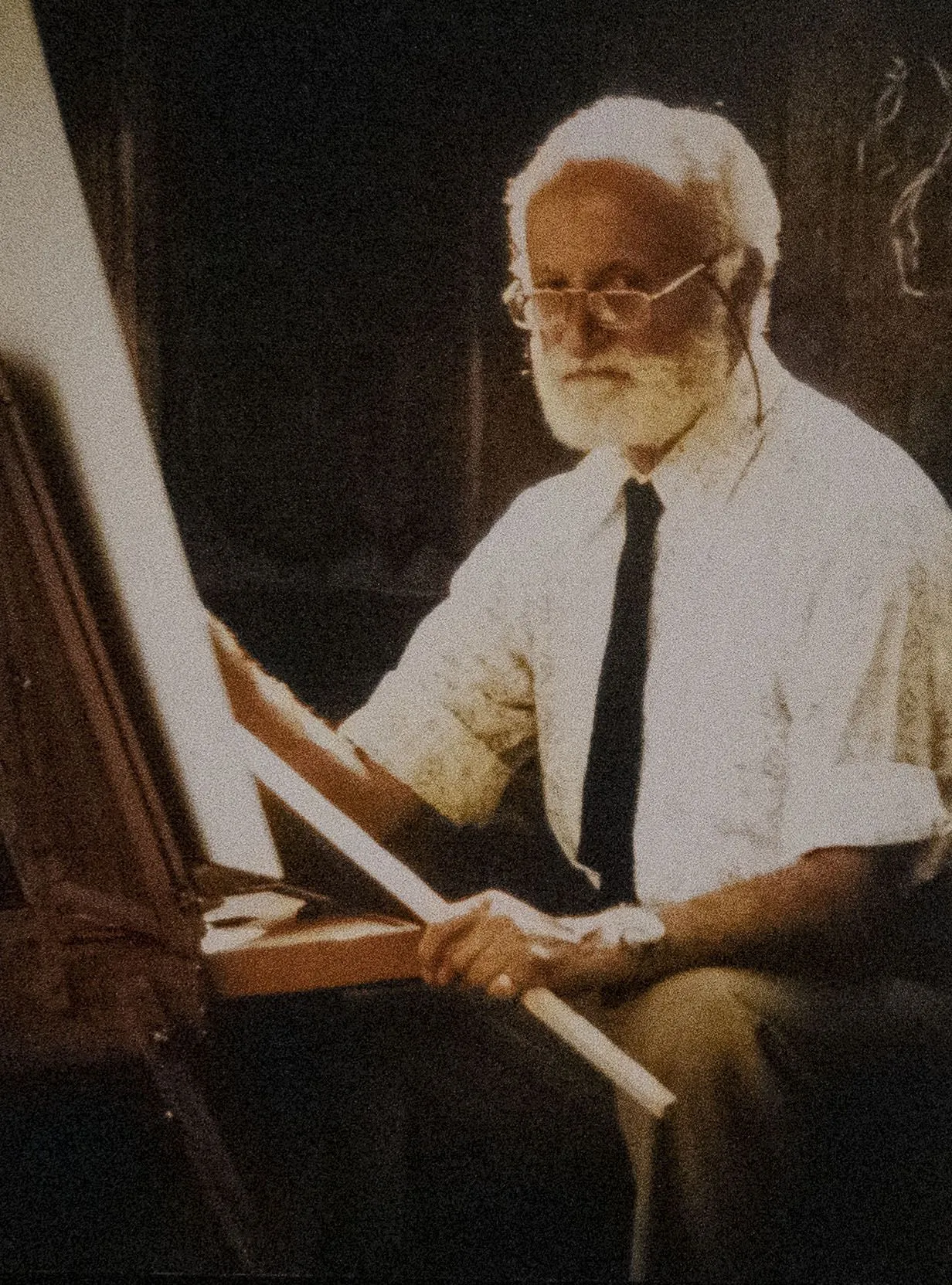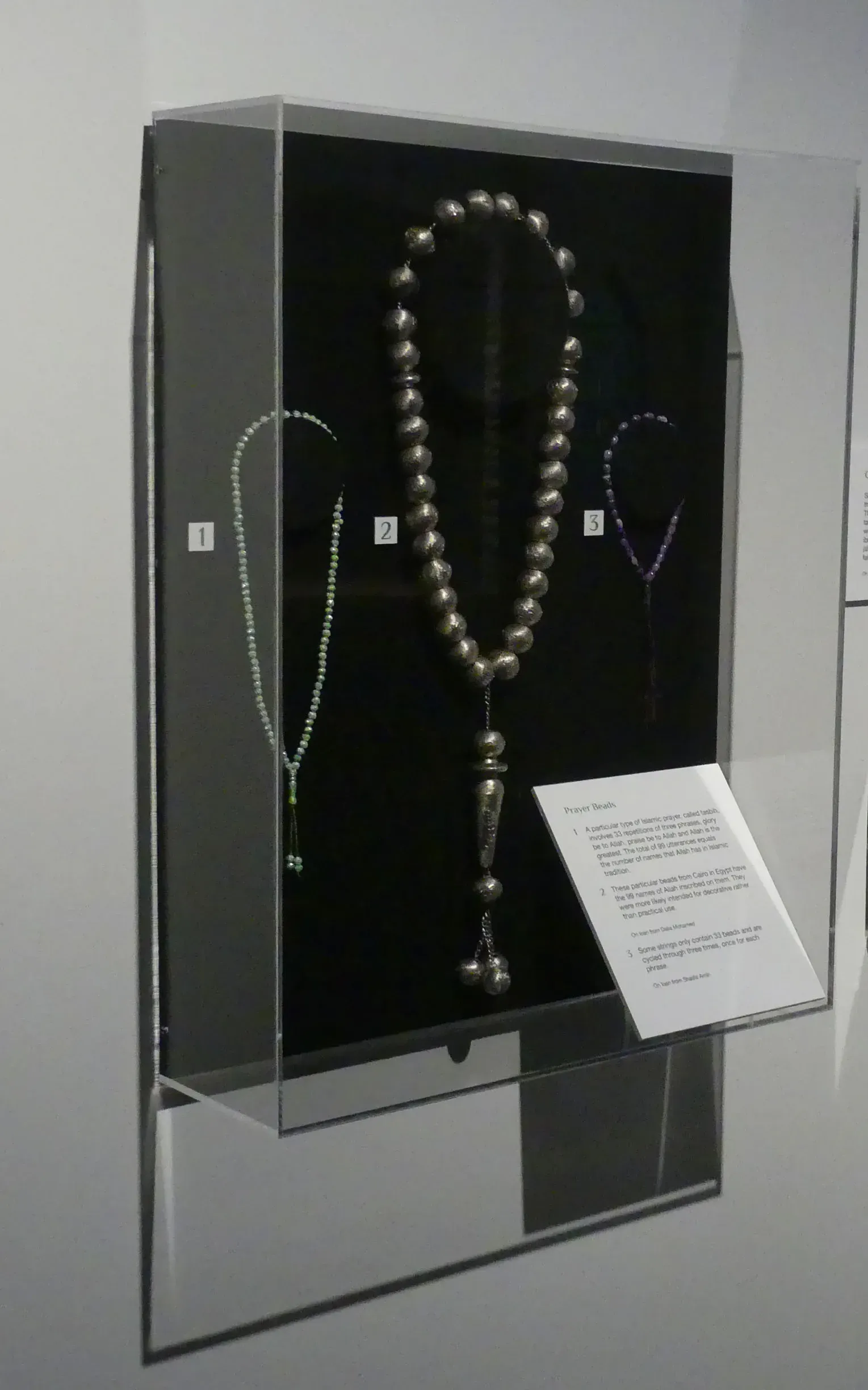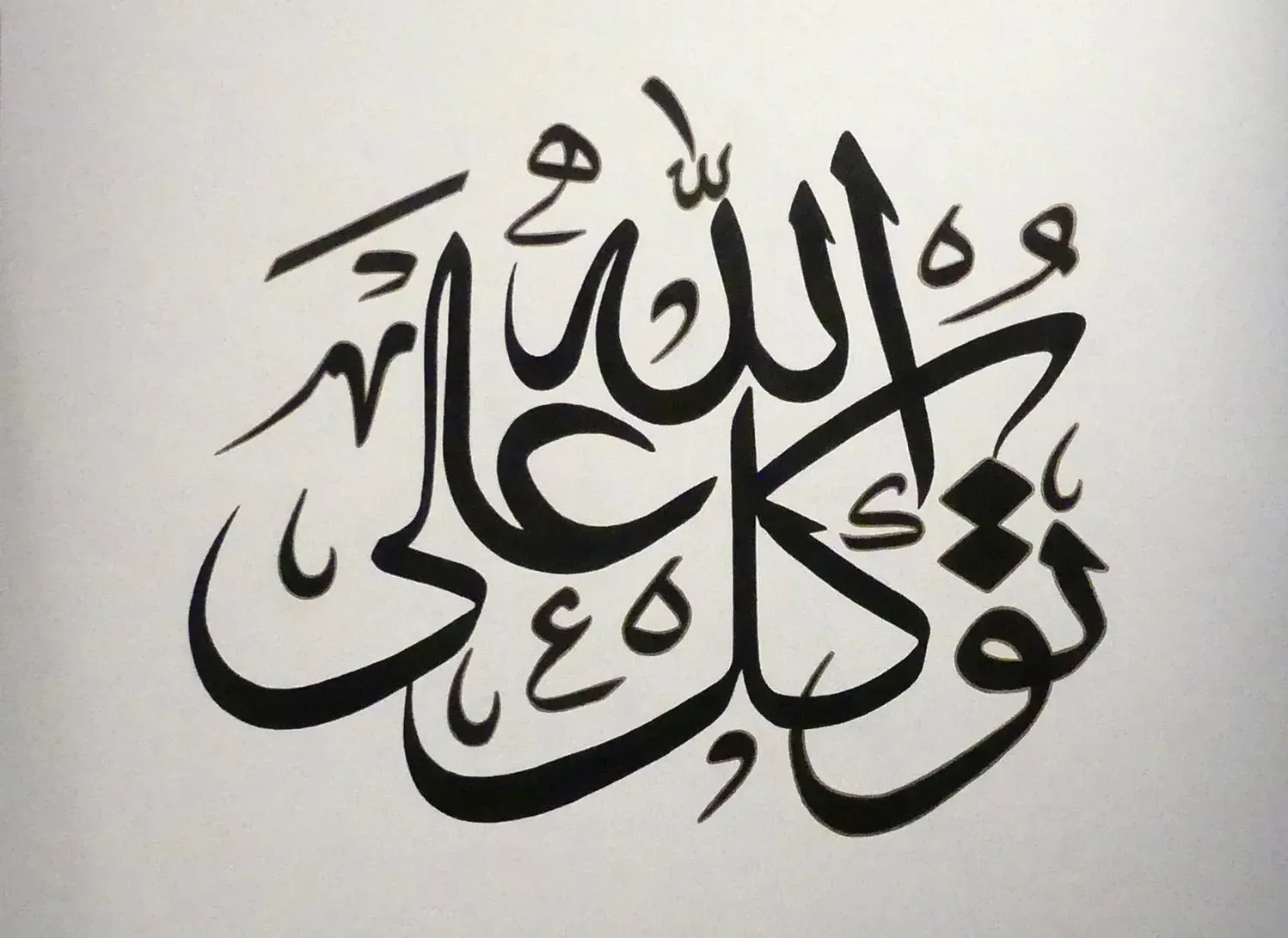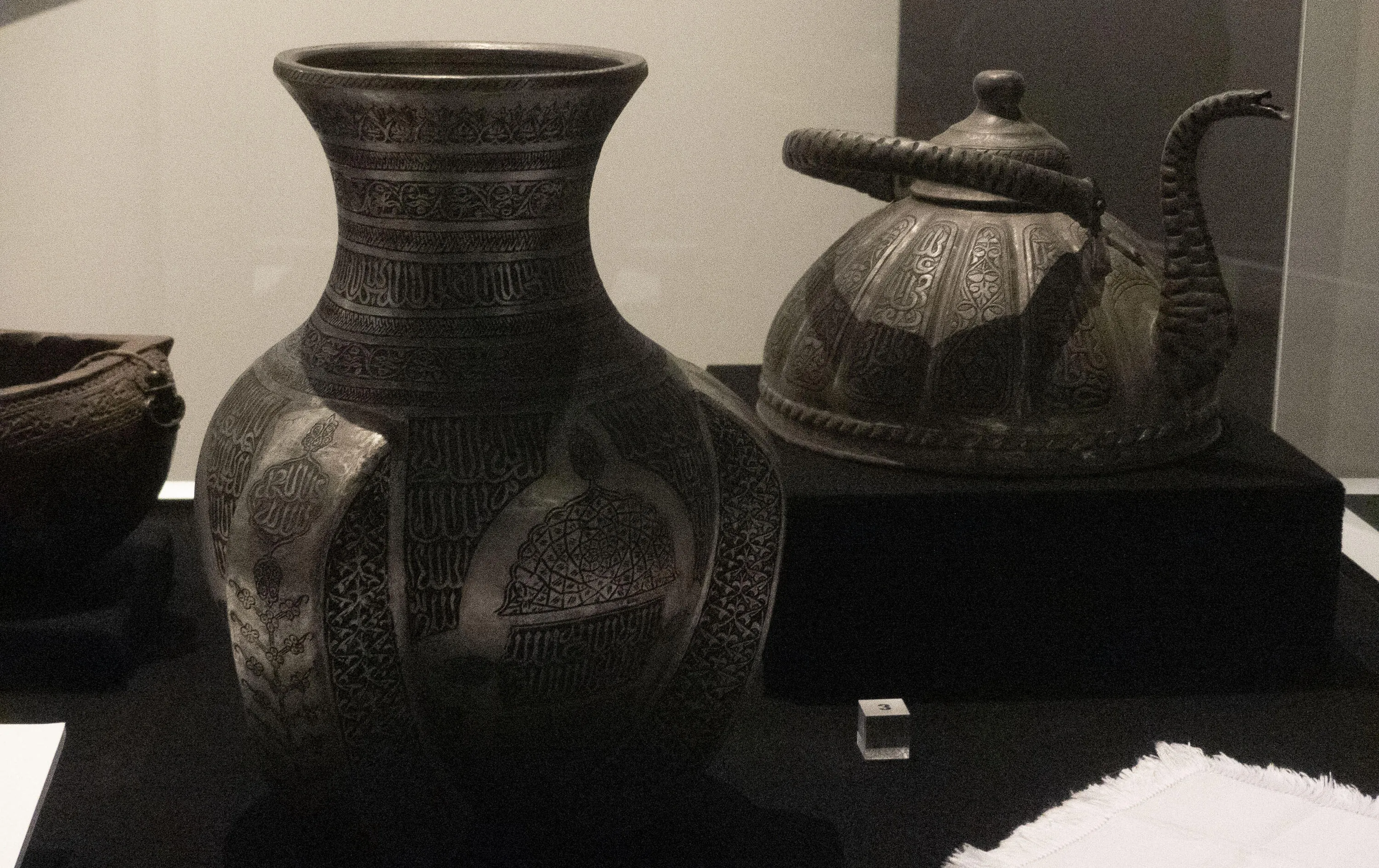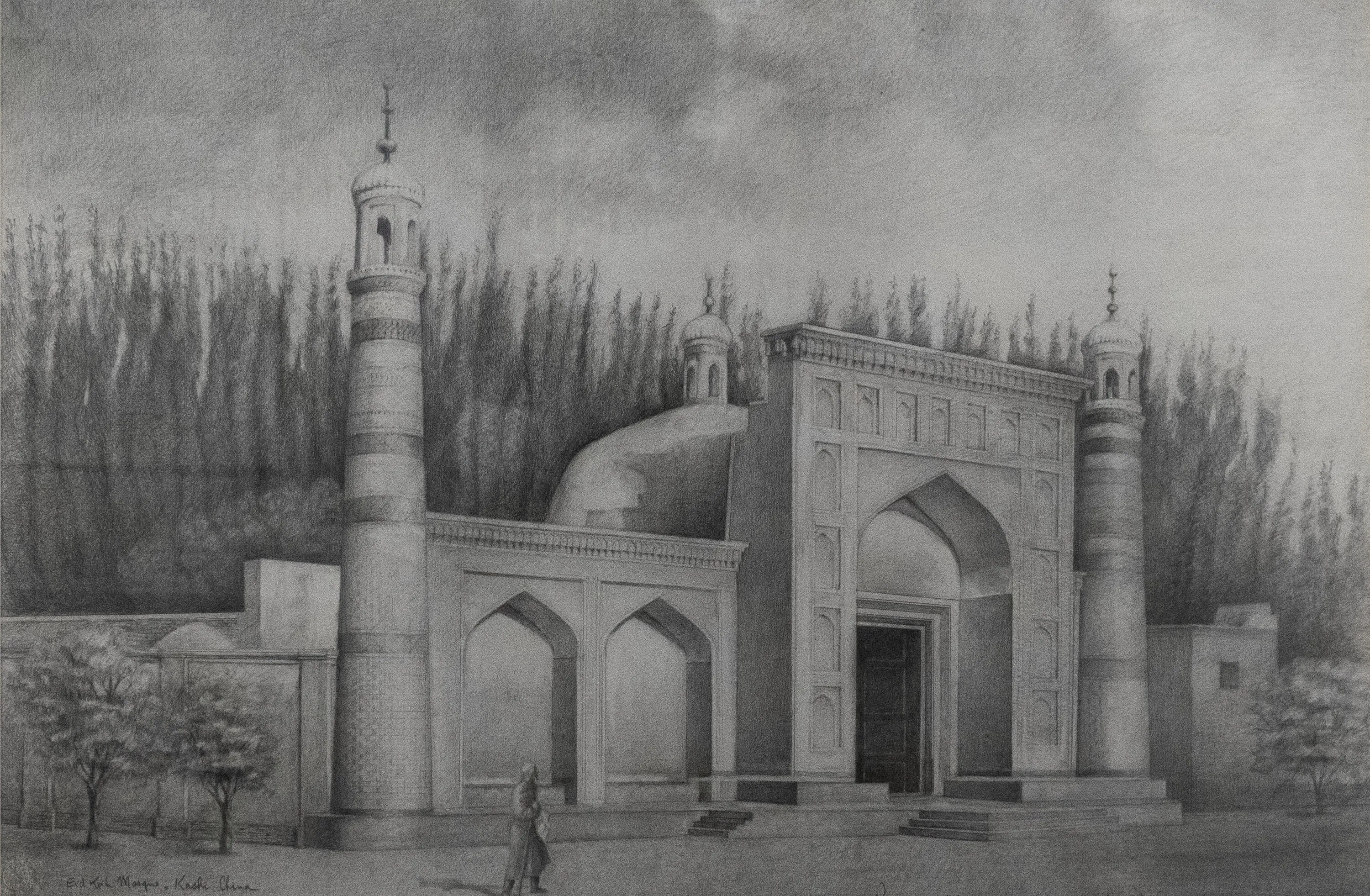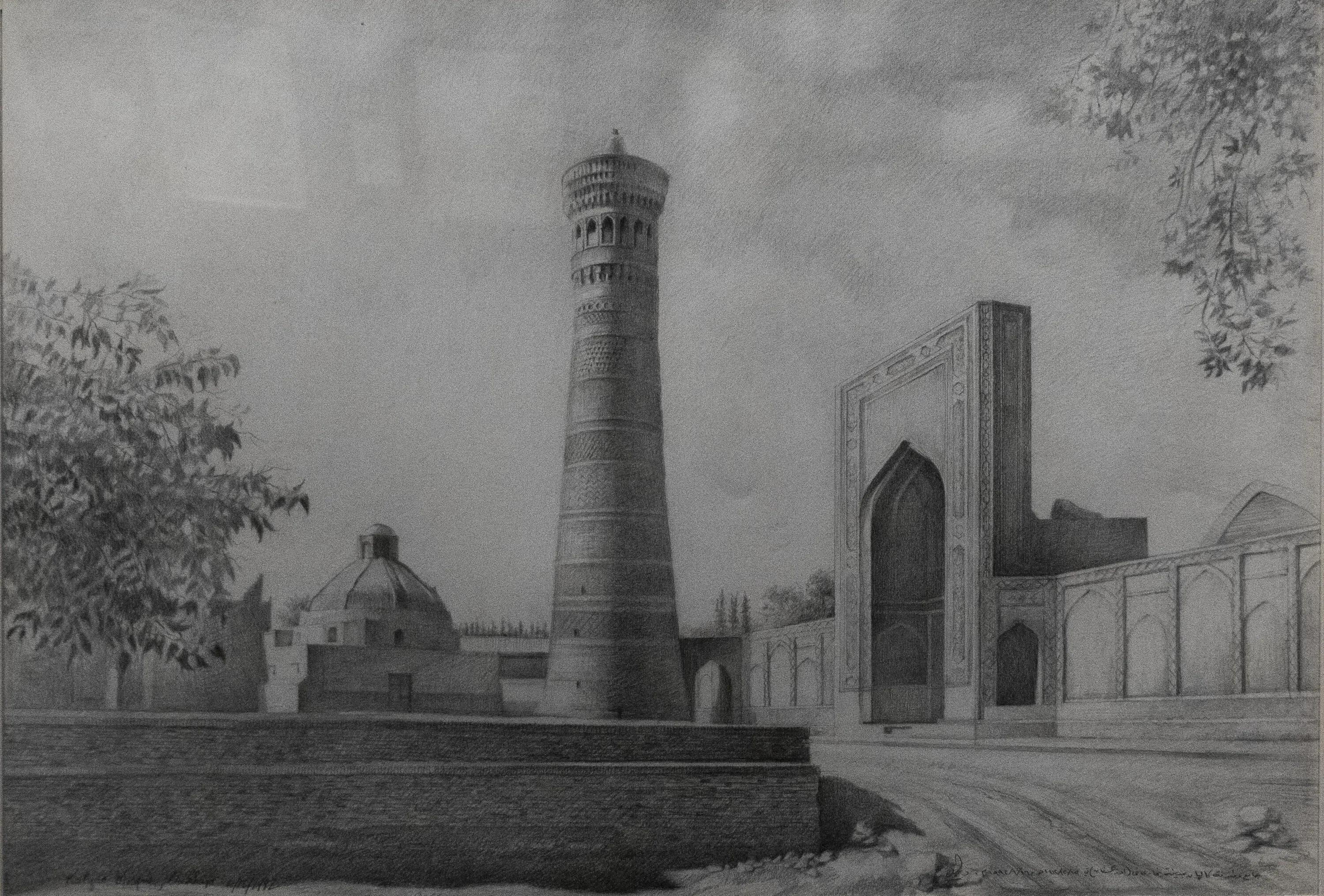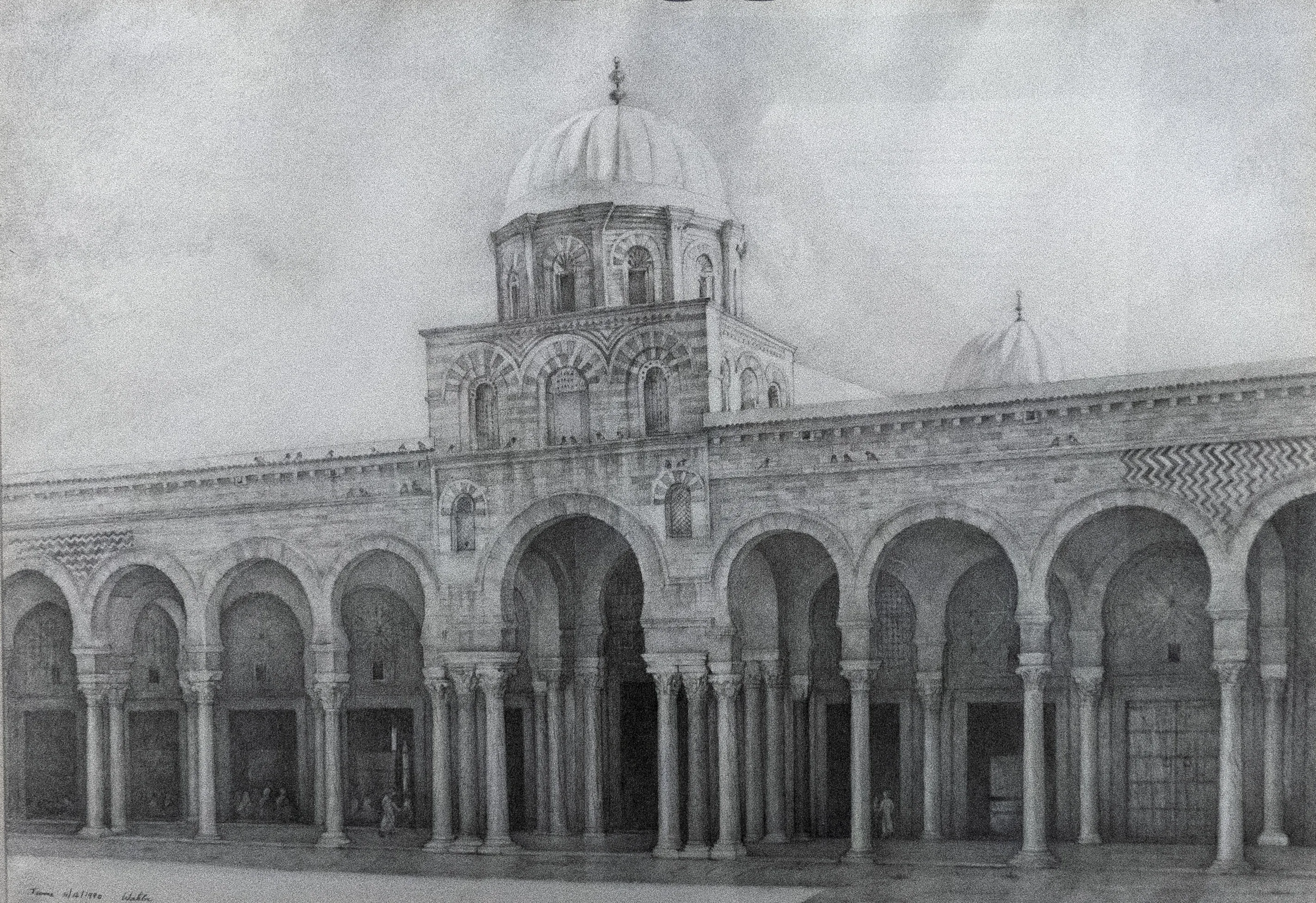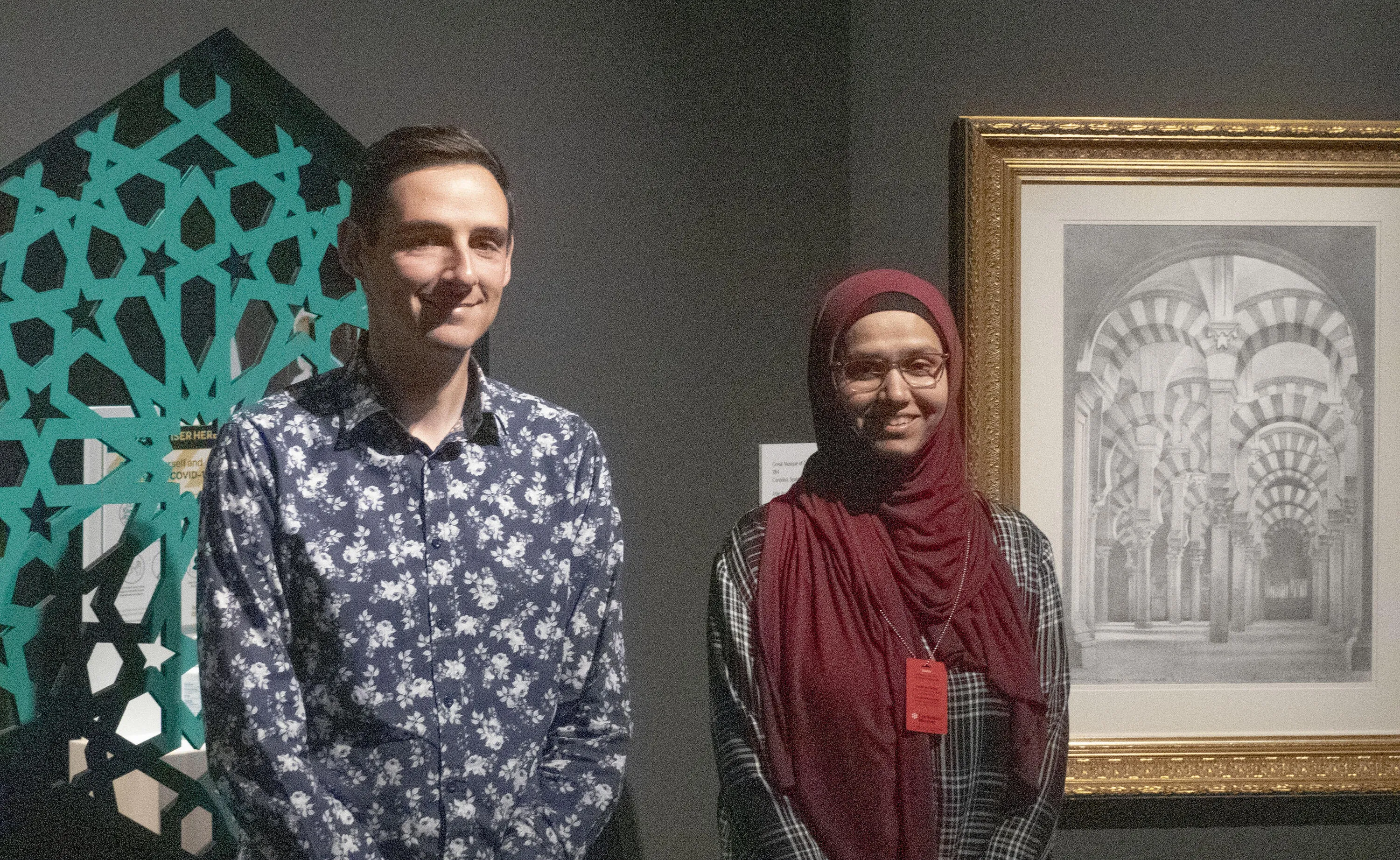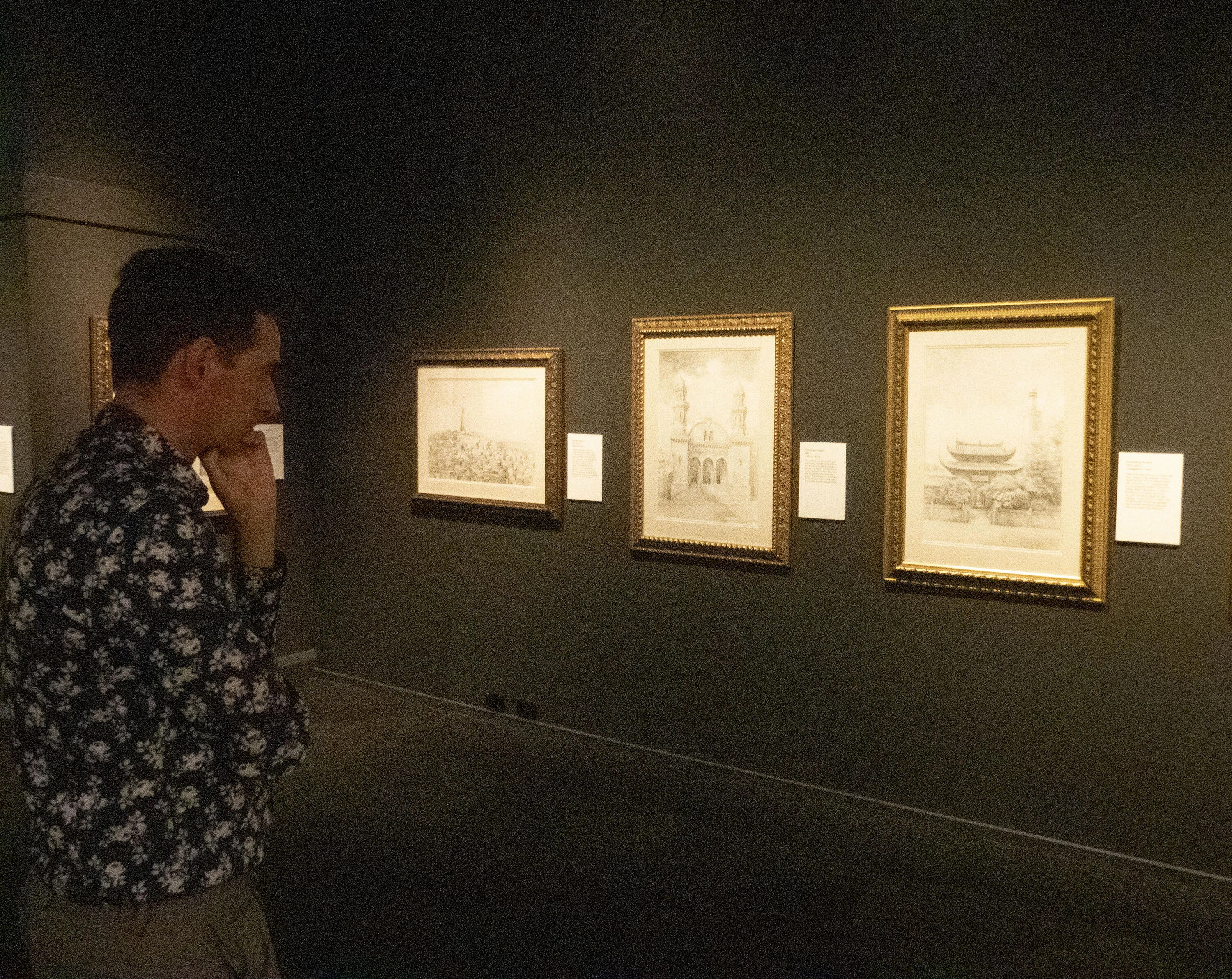Identity Underlines Artistic Inclusion
Written by
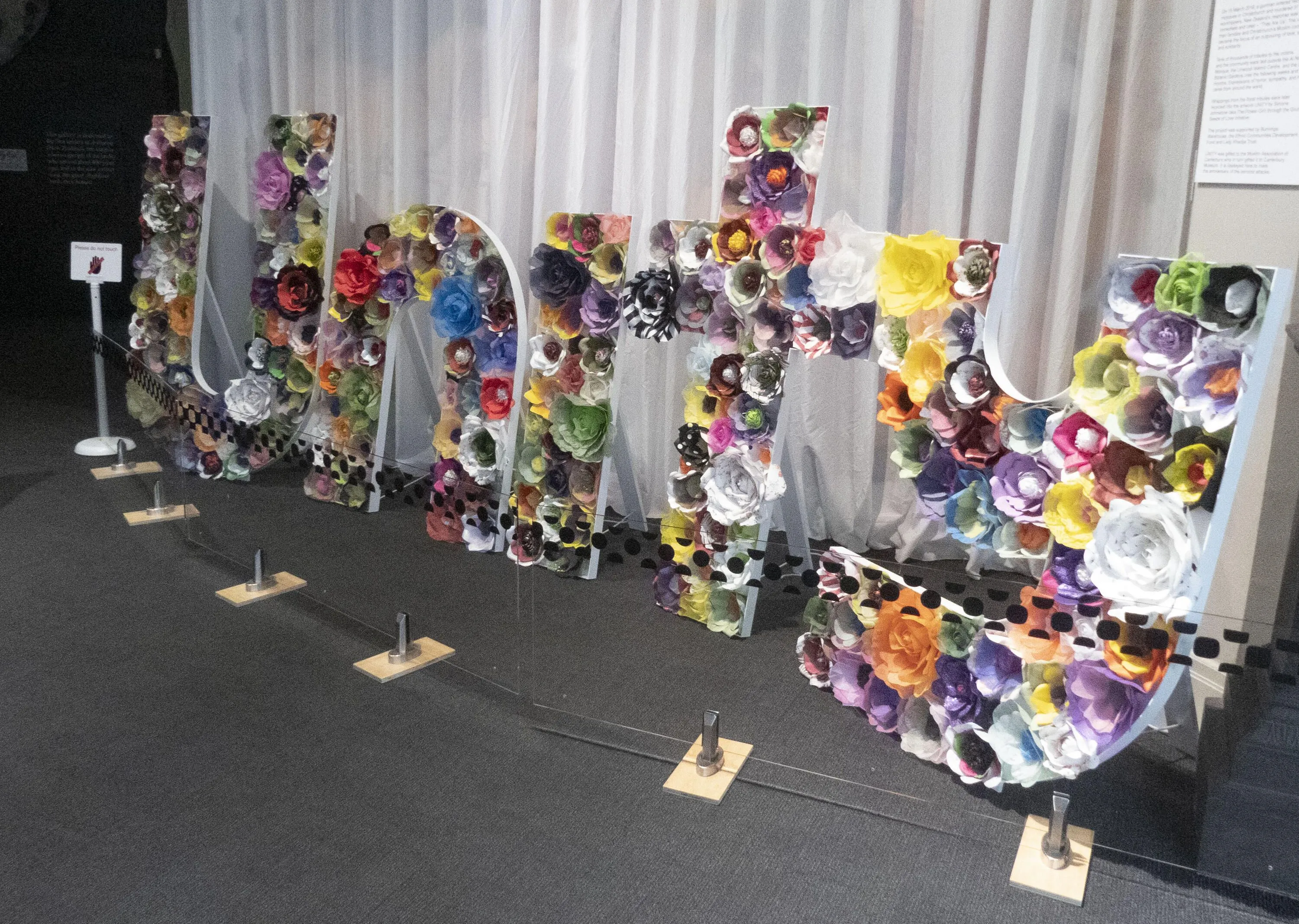
Muslims have lived in Christchurch almost as long as Europeans.
But it has taken the aftermath of unspeakable atrocity for some of them finally to feel part of the community.
Canterbury Museum has been at the forefront of that healing change with its Mosque: Faith, Culture, Community exhibition.
One of Canterbury Museum’s best-loved features is its Christchurch Street, a recreation of early Christchurch, modelled on no particular street but populated with actual business names including that most ‘establishment’ of institutions, Ballantynes. The overall effect is a genteel and prosperous Englishness – probably, to be fair, exactly what Victorian civic leaders wanted of their city at the time.
It is therefore a bit of a surprise - a disconnect - to hear while strolling down the street, a Muslim call to prayer echoing from a side door. And that’s the effect that the museum’s Curator of Special Projects, Daniel Stirland, was aiming for in setting up the Mosque: Faith, Culture, Community exhibition.
Attention grabbing
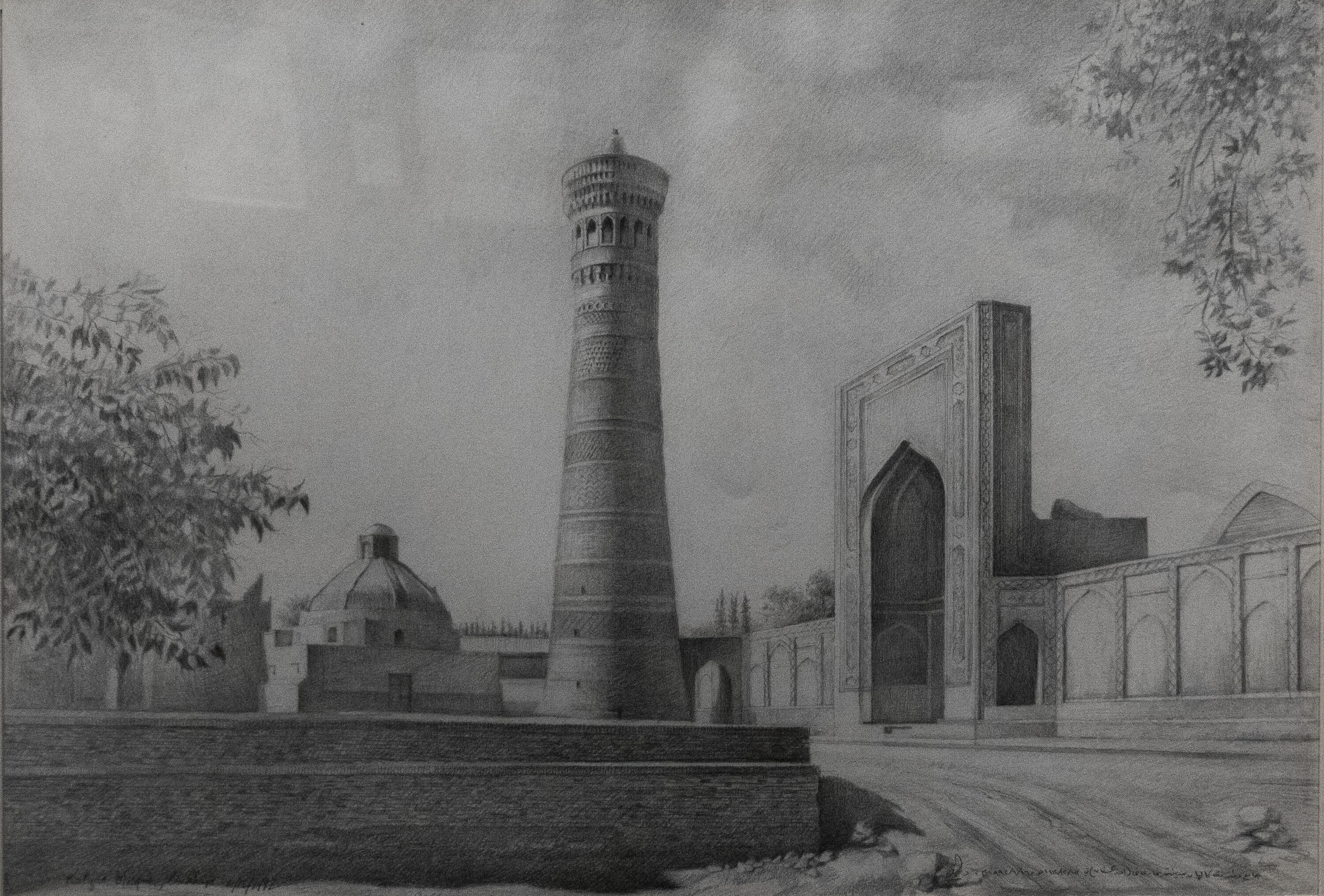
Id-Kah Mosque, 1442, Kashgar, XinJiang, China. Photo: Supplied
“The fact that people will be able to hear the call to prayer down the Christchurch Street, in what is ostensibly a Victorian display, will get them wondering ‘what's this all about, what's going on?’ and invite them in,” says Stirland.
“We wanted to do that to break down some misconceptions and reveal some information that people might not be aware of, which is that the first Muslims migrated to Christchurch in 1854 so they've been here almost as long as Europeans.
“Obviously it's the call to prayer that calls you into the mosque and so we thought it would be a really nice idea to have the call to prayer calling people into the exhibition as well,” he says.
Cultural collaboration
The Museum says Mosque was developed in partnership with Christchurch Muslims who were keen to share knowledge and understanding of Islam, and the diversity of its followers, with the wider community.
The exhibition is built around a mosque structure in the middle of the hall, to highlight the role of the mosque as the centre of both religious and community life.
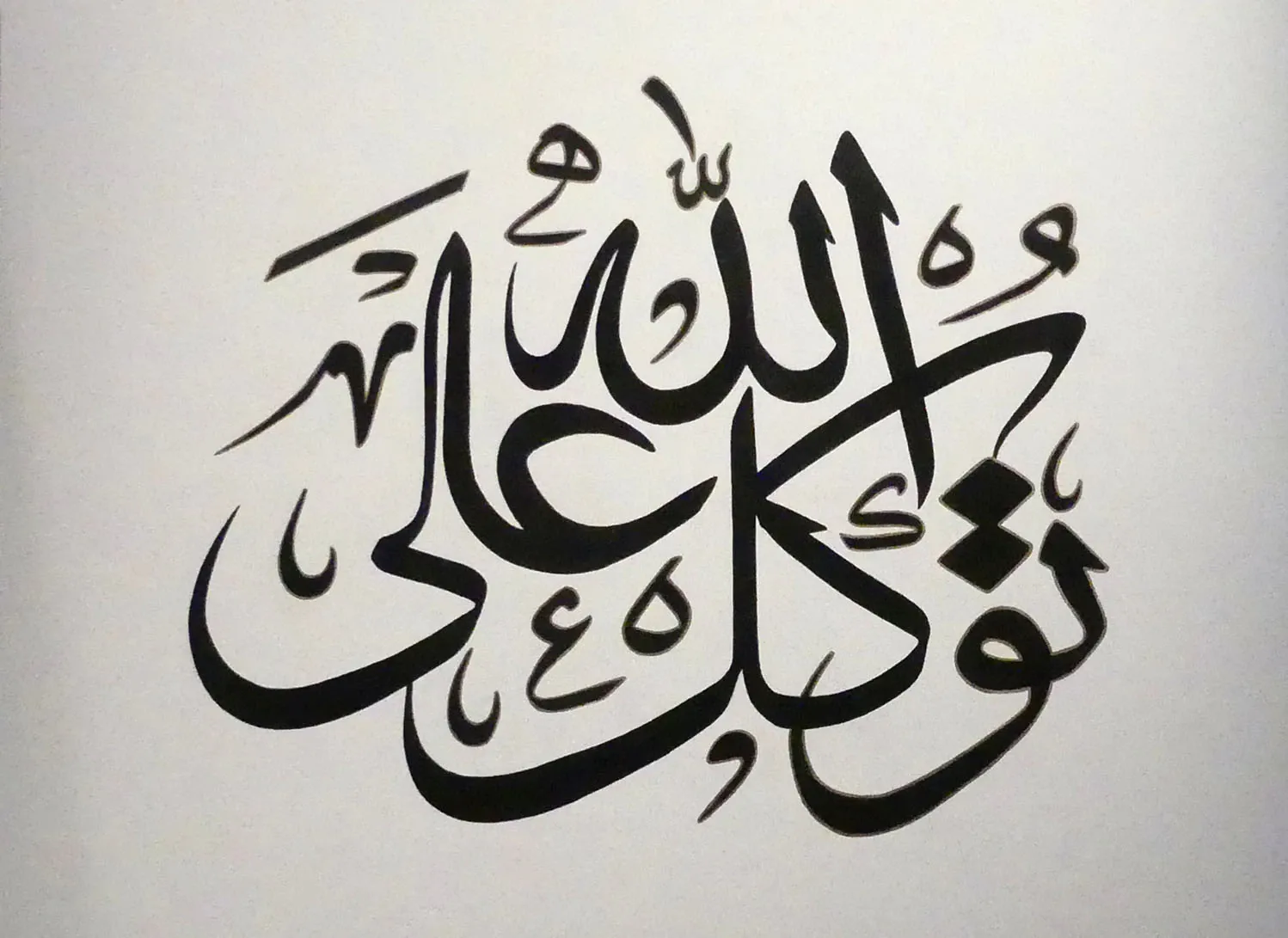
Christchurch calligraphy artist Zakkiyya Shah has contributed a number of works to Canterbury Museum's Mosque: Faith, Culture, Community exhibition. This work reads: 'Have faith in Allah's plan for you.' Photo: Nigel Malthus
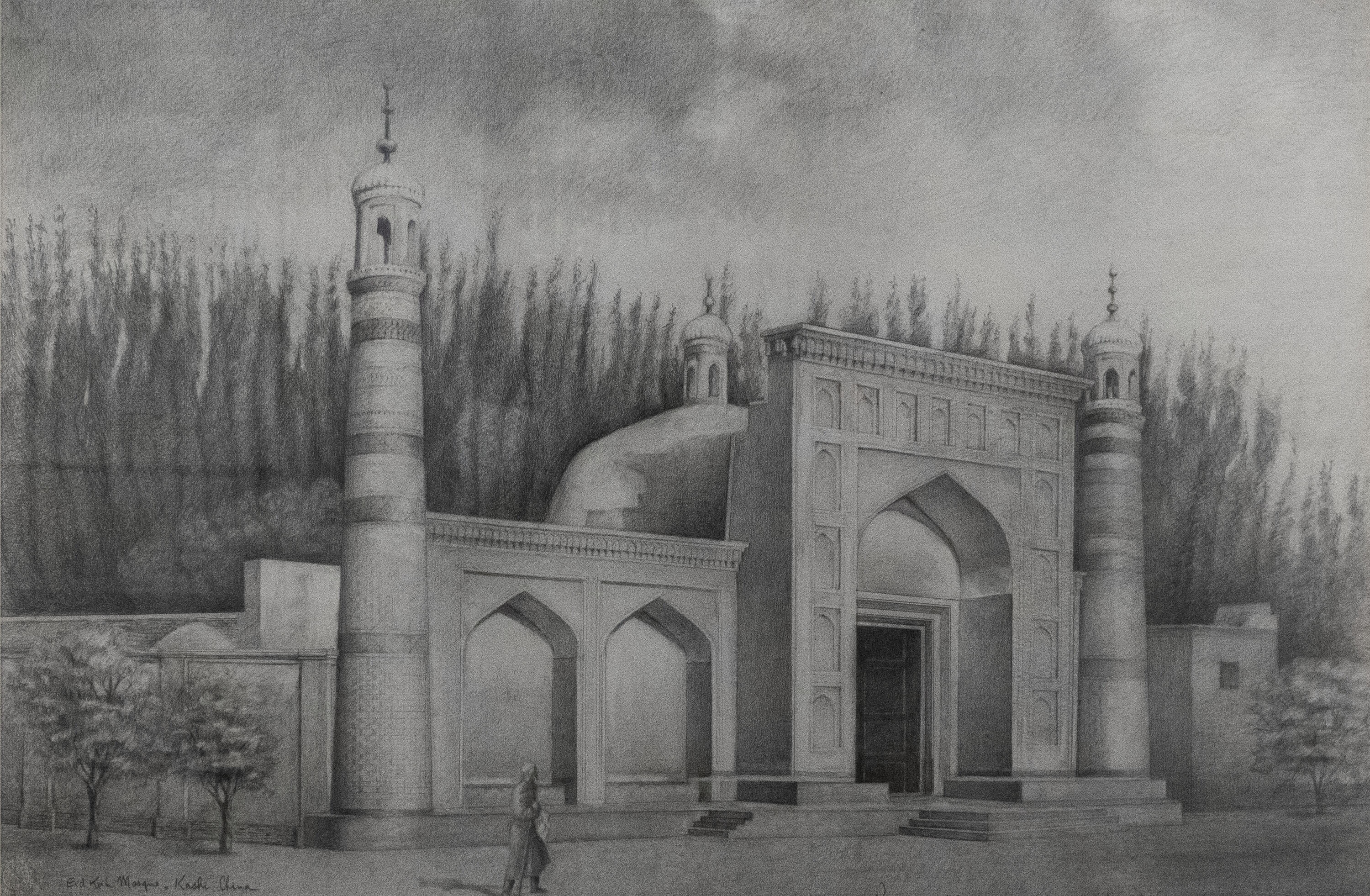
A major part of the exhibition, displayed around the walls of the hall, is Spiritual Edifices of Islam, a collection of 33 original hand-drawings of mosques around the world by Syrian-America artist and architect Wahbi Al-Hariri Rifai. The collection is on loan from GDG Exhibits Trust, Washington, D.C.
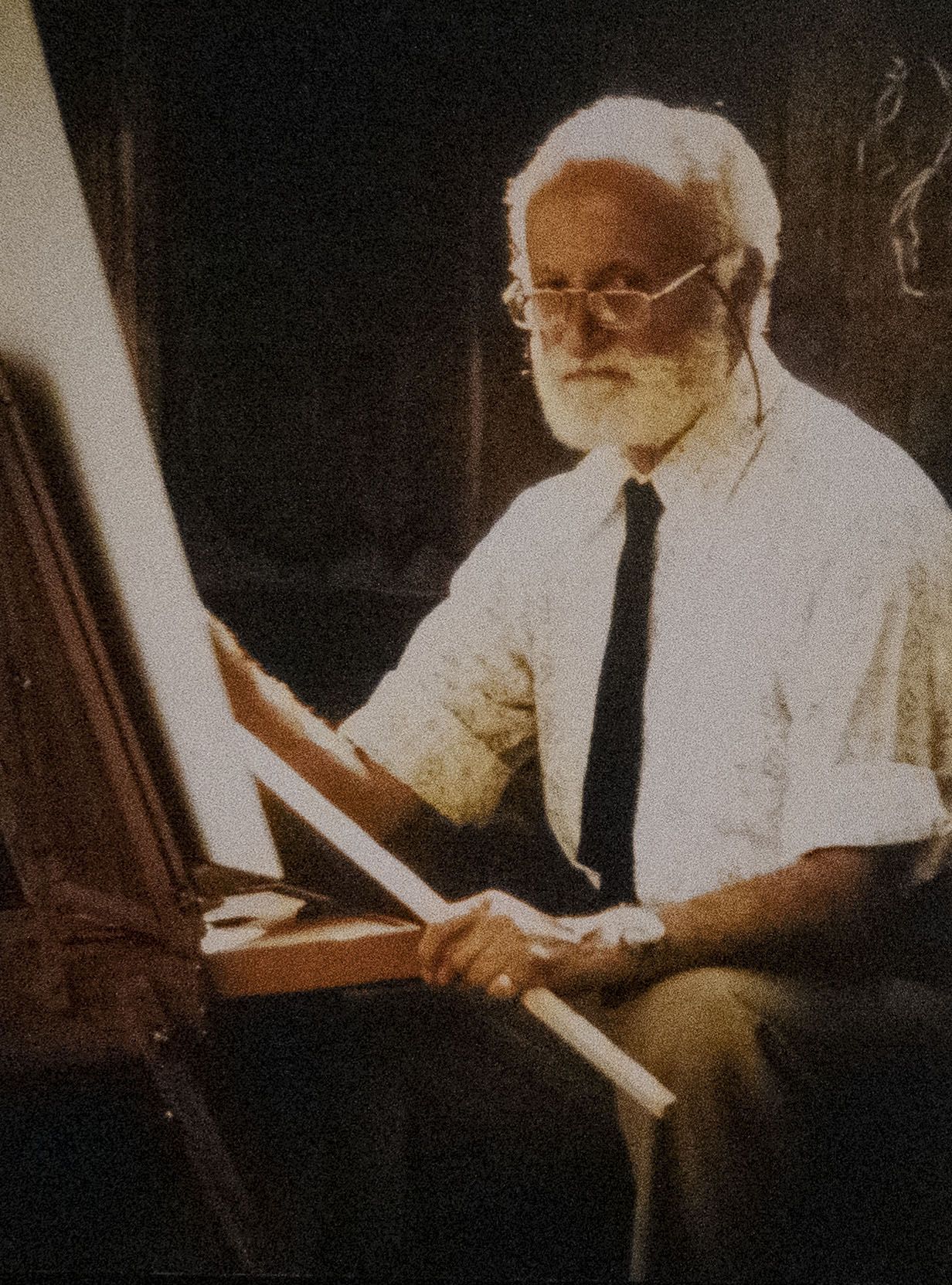
Syrian-American artist and architect Wahbi Al-Hariri Rifai's Spiritual Edifices of Islam is a major part of Canterbury Museum's Mosque: Faith, Culture, Community exhibition. Photo: Nigel Malthus
Dark days
The exhibition also – of course – marks the 2019 terrorist attacks on the Christchurch mosques, with a display centred on the spontaneous tributes and gestures of support that came in response.
Leading visitors towards it is the iconic photograph, seen around the world, of Prime Minister Jacinda Ardern wearing a black and gold headscarf in a gesture of support for the Muslim community. In a glass case is the scarf itself, which Ardern personally donated to the Museum in 2019.
But the display on the attacks is small and set aside, in deference to those who might not want to see it, and out of respect for a Muslim tradition that such events aren’t usually commemorated in a Western manner.
Filtering the aroha
As the nation remembers on the second anniversary, Stirland explains that the exhibition arose from the coalescence of three threads in the aftermath of the atrocity.
Tens of thousands of spontaneous public tributes had been laid near the mosques and other sites, and it fell to the Museum in conjunction with the Muslim community to gather them up and sort them to decide which few the museum would add to its collection to keep in perpetuity.
It was a long, painstaking and emotional experience for the two museum staffers and five Muslim representatives.
Stirland notes that much has been said about the solidarity, love and support expressed in the tributes, but there was also anger, outrage and - for some - remorse, as they realised they had to come to terms with their own subconscious racism.
“We went through every single one. Between the seven of us, we looked at all of the tens of thousands of them and we read every single card and we picked 96 to come to the museum.”
The group also became the de facto distributors of the rest – toys to Muslim children and other charities, wreaths and flowers composted and returned to the mosque gardens, and so on.
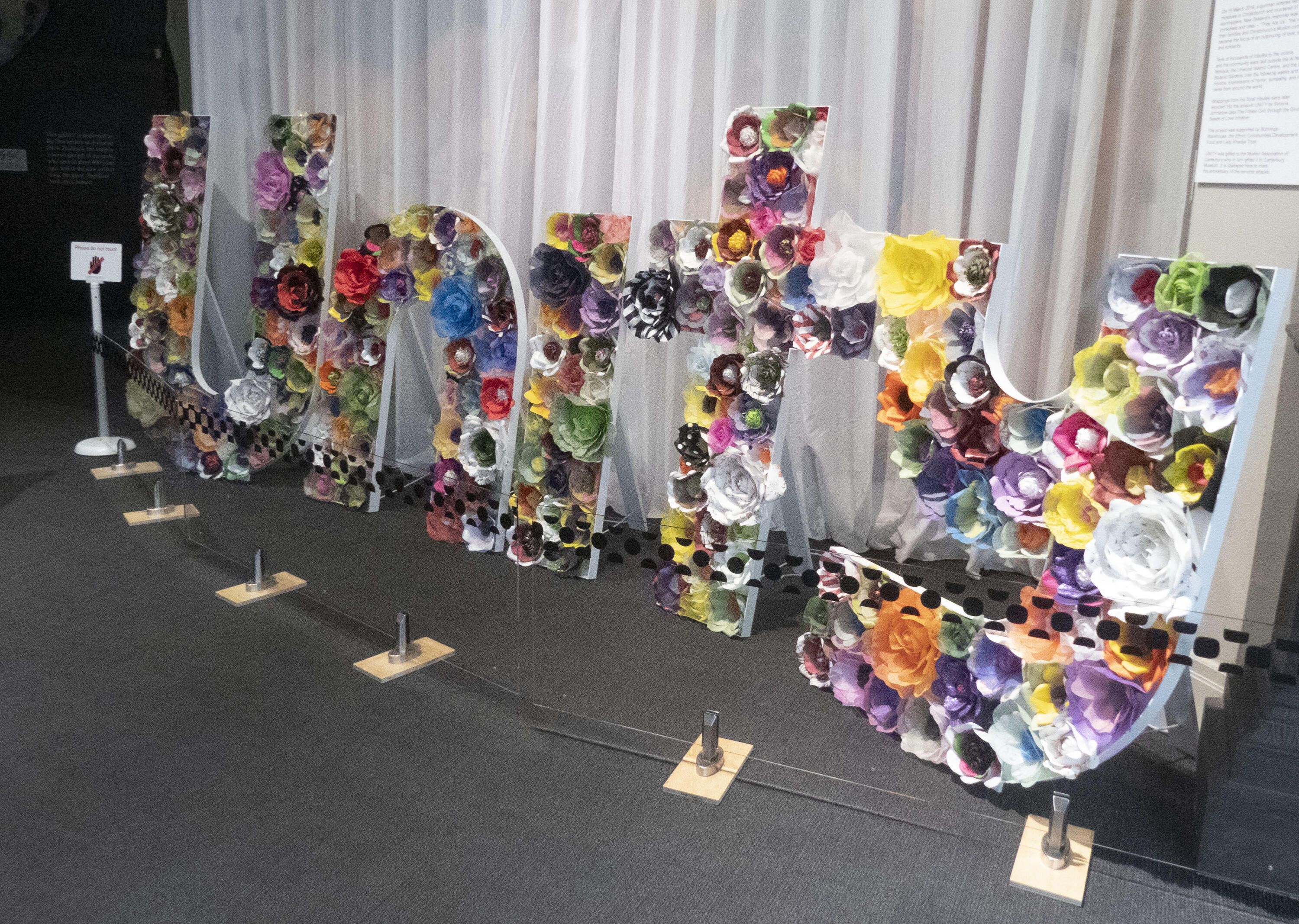
Unity, the piece produced from paper flowers collected from the spontaneous tributes left after the Mosque attacks, is back on display in the Canterbury Museum foyer to mark the second anniversary. Photo: Nigel Malthus
Some of the paper and plastic went to paper-flower artist Simone Johnstone to create the artwork UNITY, which the Museum is now holding on behalf of the Muslim community.
“Pretty much nothing went to waste. It all found a home somewhere,” says Stirland.
The second thread was the realisation that any exhibition of the tributes did not have to be just about them but could be a wider celebration of Islam and its place in Christchurch life. They knew an exhibition would be readily supported by the Muslim community loaning their own treasures and family heirlooms, while the museum itself had about 200 Islamic pieces already in its collection.
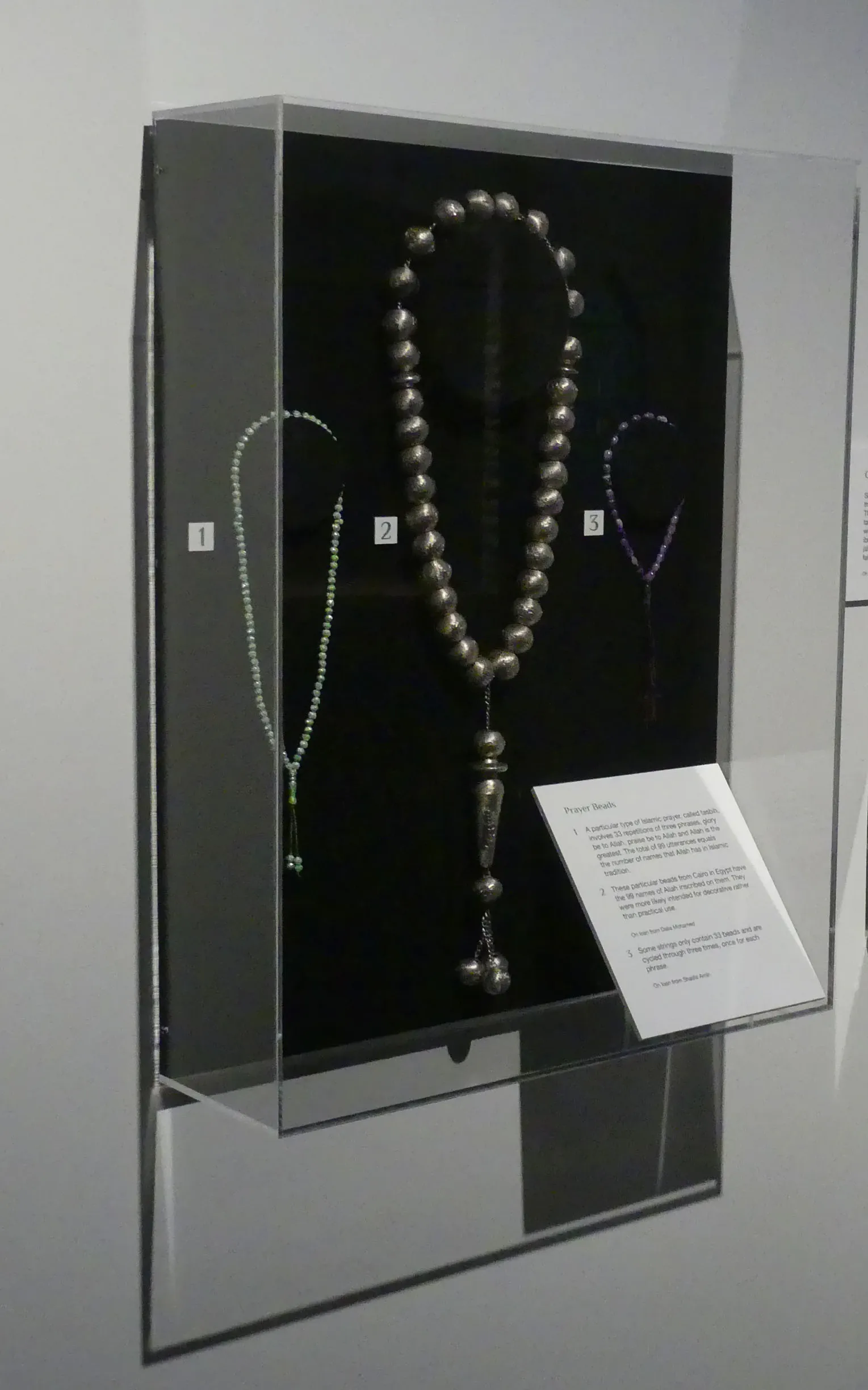
Islamic prayer beads on display as part of Canterbury Museum's Mosque: Faith, Culture, Community exhibition. Photo: Nigel Malthus
Stirland says the third thread was the many organisations around the world offering help and support in the weeks following the attack. One in particular was the GDG (Georgetown Design Group) in Washington DC, offering its collection of Al-Hariri drawings.
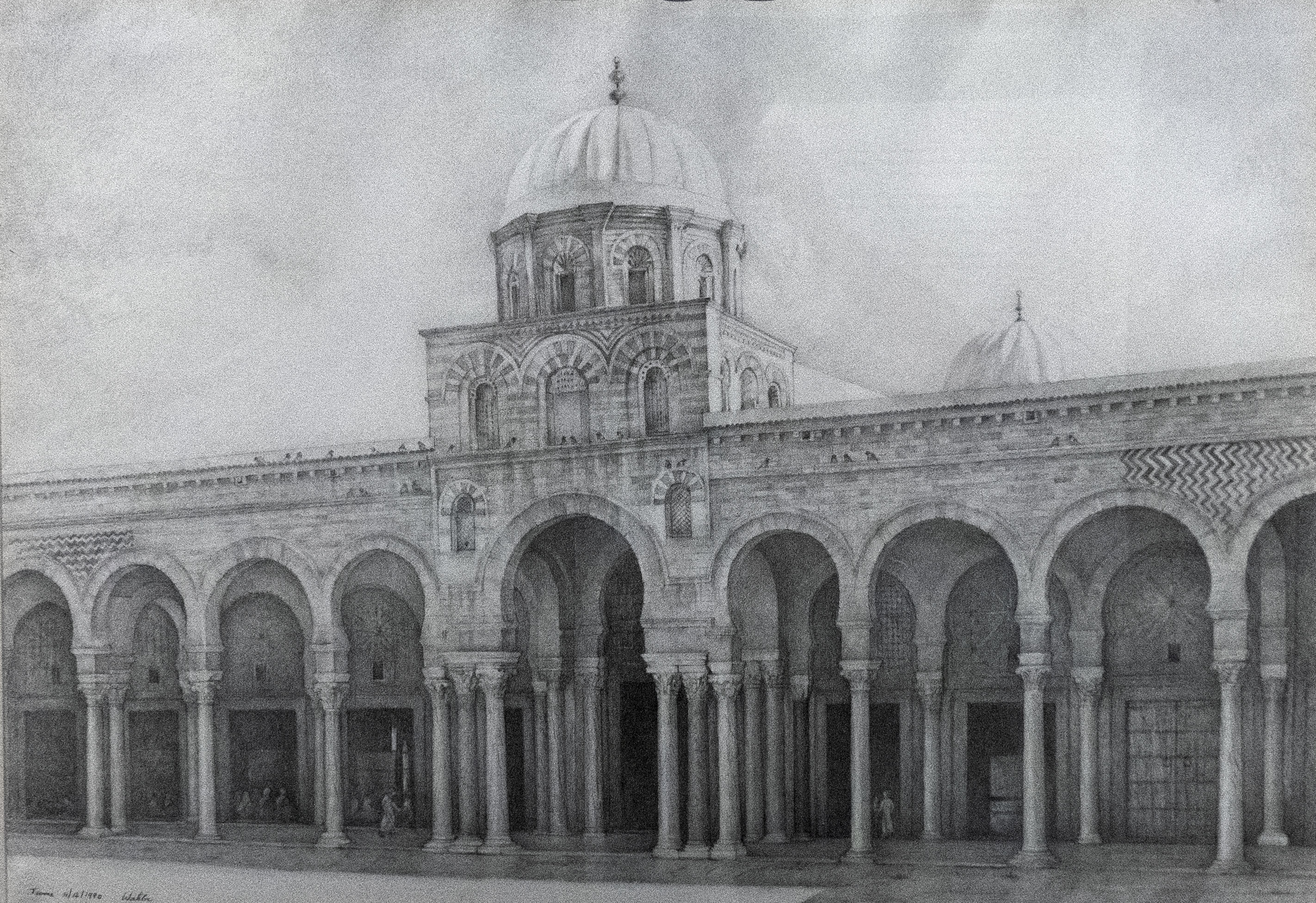
Al-Zaituna Mosque, 865, Tunis, Tunisia. Photo: Supplied
“The last place they were displayed before they came here was actually at the Smithsonian so we were quite pleased with that. It's prestigious,” says Stirland.
“So we had all these factors that we wanted to try and work into an exhibition and we resolved that the thing that linked all of these things together was the idea of the mosque.
“The drawings are of mosques; the attacks, sadly, were at the mosques. The mosque is the centre of not just religious life but community life for many Muslims ... it's something that most Cantabrians probably know very little about in reality.”
Art imitating life
The central ‘mosque’ structure is intended as a quiet place of reflection or even prayer. It’s sparsely decorated, in line with Islamic tradition that decoration should not detract from a mosque’s purpose.
“You're not going there to look at beautiful art or paintings or whatever; you're going to pray. And so we were inspired by that for this space as well,” explains Stirland.
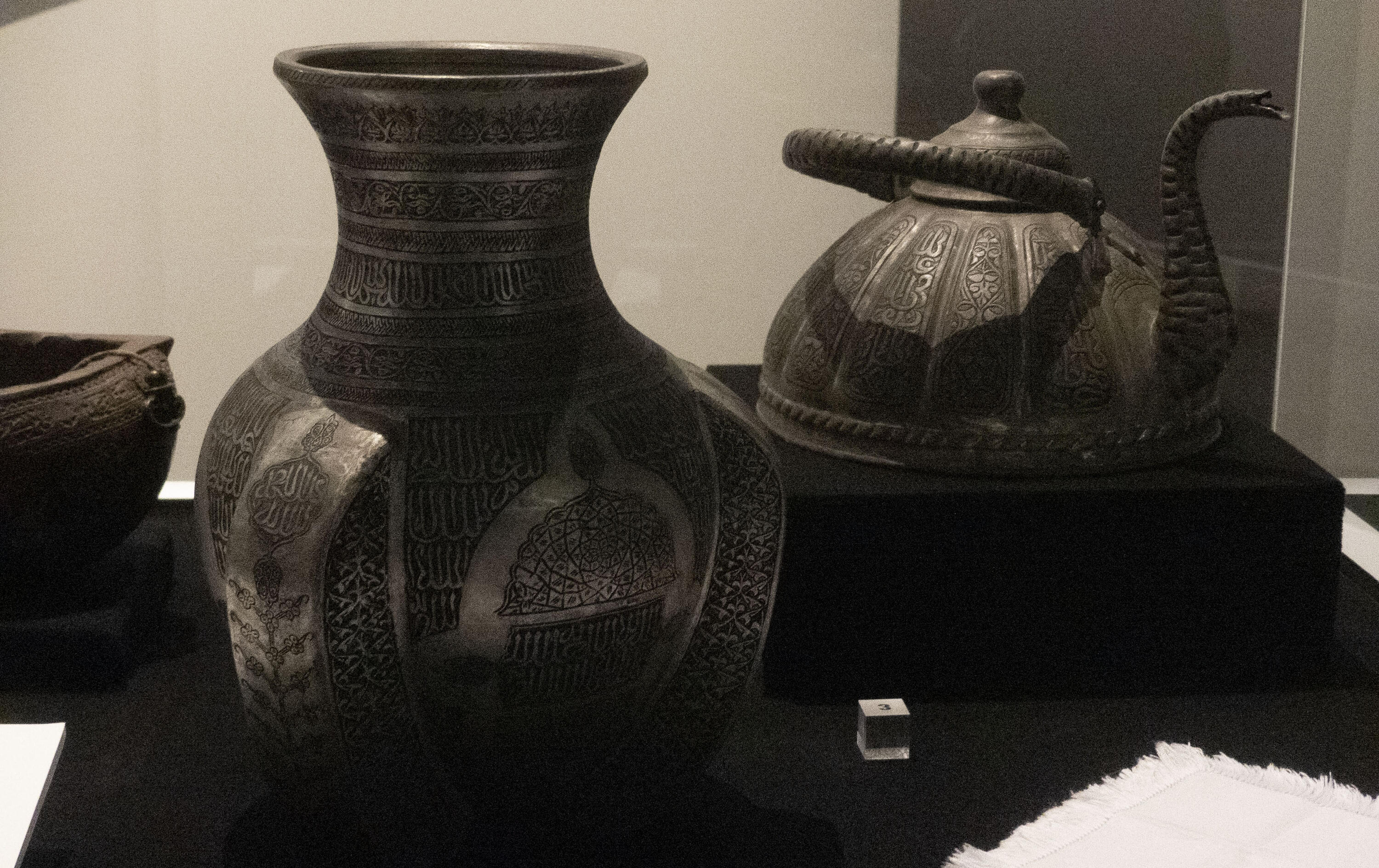
Antique Turkish inscribed metal vessels used for ablutions before prayer. They are on loan to the exhibition from a local member of the Muslim community. Photo: Nigel Malthus
The exhibition opened in December and will run to the beginning of May, having been extended beyond the usual three months, both as recognition of its importance to the community and in response to some “really positive” feedback.
Stirland cites the example of a Muslim mother who told a TV news interviewer that she could now bring her children, as their culture was now represented in the museum, whereas previously it hadn't been.
“We’ve had a few members of the Muslim community come to us and say that they didn't previously feel like the museum was their museum, and now they do.”
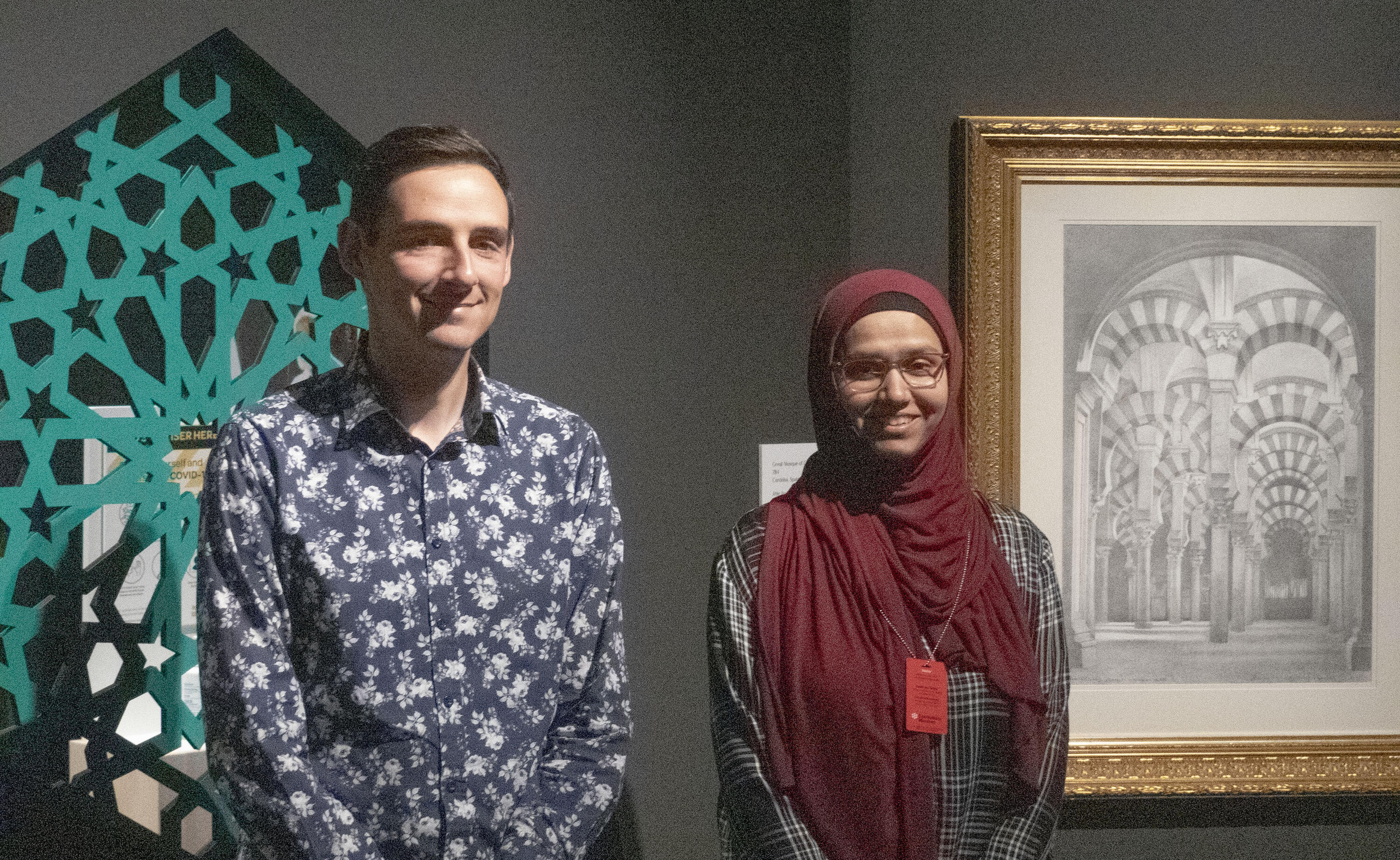
The curator of Canterbury Museum's Mosque: Faith, Culture, Community exhibition Daniel Stirland with Sarah Qader, one of several members of Christchurch's Muslim community who acted as his co-curators. The green lattice window design comes directly from windows at the Al-Noor Mosque. Photo: Nigel Malthus
Indian-born Sarah Qader, one of the five community representatives who helped sort the tributes and shape the exhibition, says she didn’t realise until her involvement that Muslims had been in New Zealand for so long, but she now feels a connection.
“I have come to the museum before and usually it's something ‘else’. I never felt the right to be represented in any way,” she says.
“We feel it’s achieving everything that we set out to do,” adds Stirland.
“It's not about the tributes, it's not about shootings. It's about Muslims in Christchurch, it's about the cultural diversity of Islam and it's about breaking down the false ideas that people have got.”
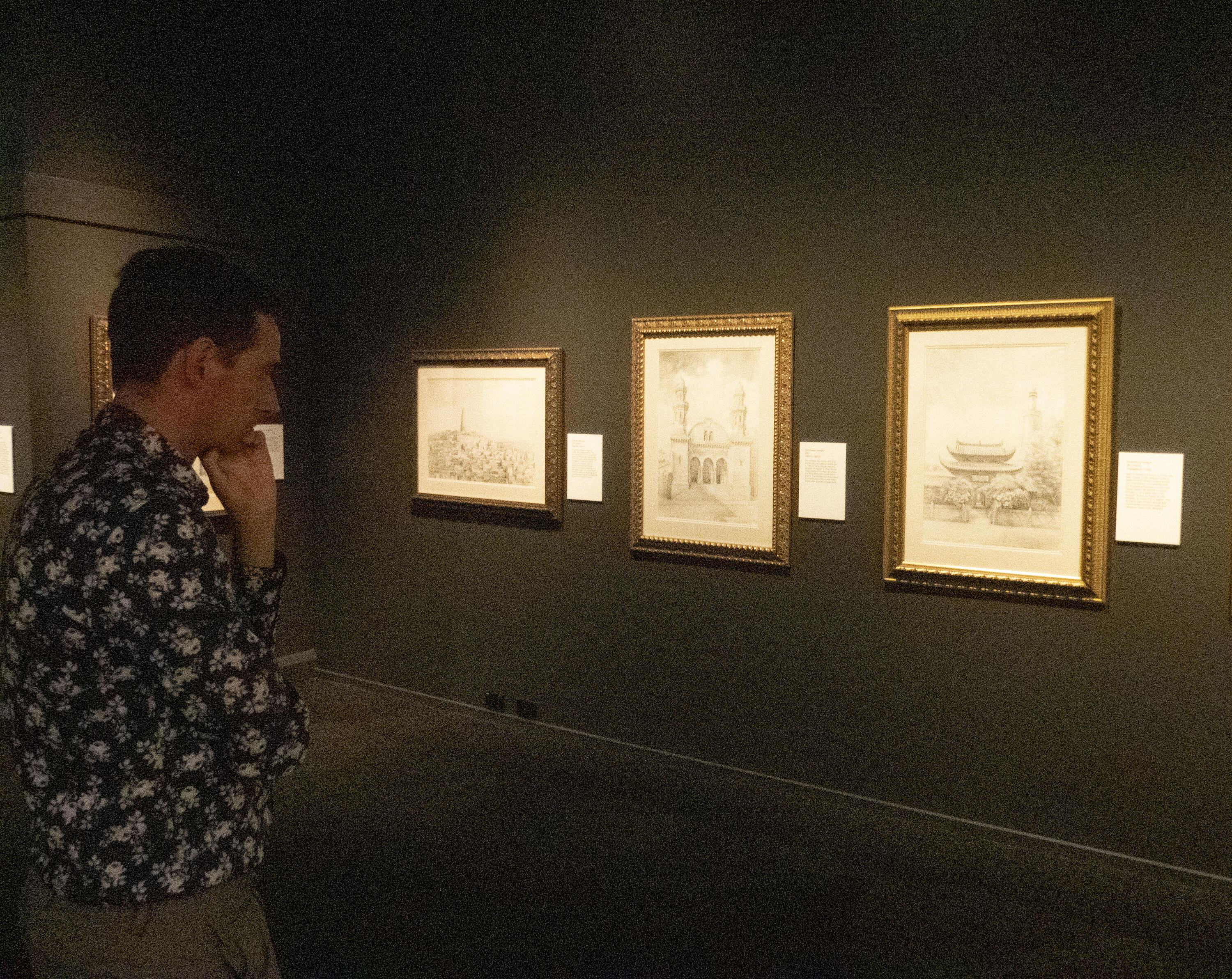
The curator of Canterbury Museum's Mosque: Faith, Culture, Community exhibition Daniel Stirland with some of the pencil depictions of Mosques from around the world which form a large part of the exhibition. Photo: Nigel Malthus
UNITY, the artwork produced by Johnstone out of salvaged paper and plastic, has been erected in the museum foyer to help mark the second anniversary. The museum has also put online a collection of more than 500 photographs it commissioned at the time, of mourners, remembrance services, the sea of spontaneous public tributes and the volunteers working to sort them for donation or archiving.
